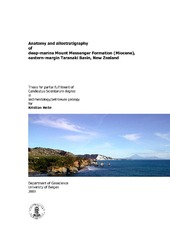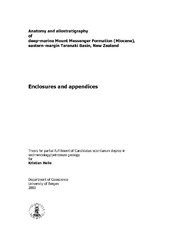| dc.description.abstract | Purpose of study: Sedimentological description of outcropping deep-water clastics within Mount Messenger Formation. Study area: North-Taranaki coastal region, North Island, New Zealand. Methodology: Mapping on foot and sedimentary logging. Geological setting: The basin-floor fans and channel levee complexes of Miocene Mount Messenger Formation were deposited in fore-deep, intra (sub) continental Taranaki Basin. The basin is mainly submarine, but Mount Messenger Formation crops out in the study area with a thickness of approximately 700m. The lower part is dominated by mid fan deposits, the middle part by lower fan deposits, and the upper part by channel-levee deposits. Lithofacies and lithofacies associations: 4 lithofacies associations have been recognized in the lower and middle part of Mount Messenger Formation; 1) massive sandstone association consist of thick beds of massive very fine to fine grained sandstone interbedded with very thin beds of mudstone interpreted as deposits from gravity-flows with laminar flow component interbedded with hemipelagic mud; 2) heterolithic association consist of interbedded thin beds of very fine to fine grained sandstone and mudstone interpreted as high-density turbidity current or sandy debris-flow deposits interbedded with hemipelagic mud; 3) finely-laminated association consist of thick beds of finely-laminated very fine to fine grained sandstone interpreted as turbidity current deposits; 4) deformed association consist of very thick-bedded, heavily deformed interval interpreted as slump-flow deposits. Architectural elements: 3 types of architectural elements are recognized; 1) massive sandstone association or finely-laminated sandstone association dominated sandstone elements interpreted as mid fan deposits; 2) heterolithic association dominated heterolithic elements interpreted as lower fan deposits; and 3) deformed association dominated deformed elements interpreted as deposits from slope failure. Allostratigraphic units: The architectural elements are stacked in successions of sandstone element ― heterolithic element ― deformed element which each define an allostratigraphic unit bounded by the lower erosive surface of sandstone elements (cycle boundaries). A total of 4 units are recognized. Allostratigraphic architecture: The sandstone elements at the base of each allostratigraphic unit are interpreted to represent different depositional environments within the mid fan setting. The depositional environment changes with time from outer mid fan to middle mid fan to inner mid fan, reflecting the overall progradation of the depositional system into the study area. Paleocurrent measurements indicate the direction of progradation was towards the north-west. Paleogeography: Mount Messenger Formation is interpreted as multiple sourced, moderately efficient, shallow incised, channel attached depositional system. Paleocurrent measurements indicate that Allostratigraphic Unit 1 and 2 were fed from 2 sources; slump-flows from the north and sandy gravity-flows from the south-east. Allostratigraphic Unit 3 and 4 were fed from a source located to the south. The formation can be classified as a hybrid between a sand-rich slope apron and a mixed sand-mud slope apron depositional system in the classification introduced by Reading & Richards (1994). Controls on stratigraphic architecture: 3 stratigraphic time hierarchies are recognized within the studied deposits; 1) onset of Mount Messenger deposition representing a low-frequency hierarchy with several million years or more duration interpreted to result from interacting factors of sediment supply, subsidence and eustasy, but ultimately controlled by the uplift in the south-east; 2) rhythmic stacking of architectural elements representing a medium-frequency hierarchy with 100-200 thousand years duration interpreted to result from tectonic processes; and 3) thinning-up successions within architectural elements representing a high-frequency hierarchy with 10’s of thousands years duration interpreted to result from autogenic processes. | en_US |

